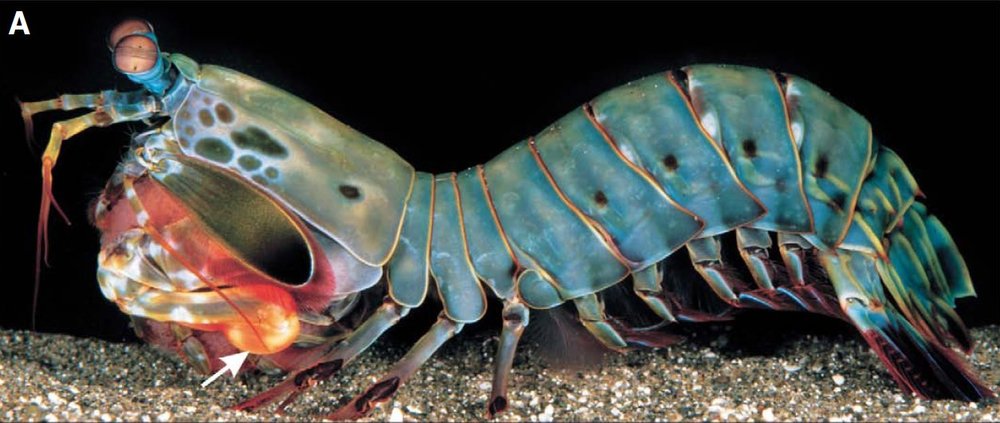Greetings everybody,
I know what you are thinking, how in the world did Biobunch come across this weird sounding animal? Well I owe it all to 'The Book of Barely Imagined Beings' I got for Christmas last year! Do not let the word shrimp confuse you the Gonadactylus are lethal little predators packing a serious whack!
Conservation status: Not listed
Habitat: This little shrimp is found on reef flats and believe it or not dead and live coral. They bury cavities in the coral and take root there. Their range is thought to be between New Caledonia all the way to the Western Indian Ocean.
Length: 8-90mm
Now what characteristic to focus on for this colourful little guy... I suppose could focus on its supposed 'genital fingers'
First things first, does this shrimp actually have genitals for fingers? It would be quite amusing but - no. No this shrimp does not have genitals for fingers, however, the scientist who first found this shrimp is thought to have amused himself by thinking that they were and thus named it accordingly.
All jokes aside, this gherkin sized shrimp is probably one of the most efficient killing machines to be found in nature. Their typical victims fall under the shelled organisms variety, such as oysters, crabs and snails. Gonodactylus fall under one of two hunting types, you have the smasher and the 'spearers', neither sound very appealing so lets have a look a little closer.
The shrimp you see above is a 'smasher' and the blow that they deliver is equal to a force of 1,500 N and is over in just a fraction of a second. That's not all for defenceless prey item, the speed at which the first blow is delivered causes a process called cavitation to occur, whereby a partial vacuum in the water behind the shrimps lethal weapons is formed. This is acts as the second shell crushing blow. Never judging a book by its cover is crucial in the case of the Gonadactylus as a punch from this could lead to a broken bone!
In the case of the spearers as the name suggests, these shrimp carry out the art of skewering their prey on the very sharp barbed points on their front limbs. Lovely! Look at the image below for the variety of shapes and sizes of the Gonadactylus's appendages.
The brutality through which these Stomatopods kill in combination with spectacular vision makes them a near to perfect 'killing machine'. As such, the overall design of these little shrimp have remained relatively untouched for what is thought the past four hundred million years! I suppose if you have the perfect design then why change it?
That bring us to the end of our post guys! As alway it has been a pleasure posting for you, remember to keep up with the blogs twitter account. Until next time.
Biobunch,
Over and out.
I know what you are thinking, how in the world did Biobunch come across this weird sounding animal? Well I owe it all to 'The Book of Barely Imagined Beings' I got for Christmas last year! Do not let the word shrimp confuse you the Gonadactylus are lethal little predators packing a serious whack!
 |
| Image Source |
Conservation status: Not listed
Habitat: This little shrimp is found on reef flats and believe it or not dead and live coral. They bury cavities in the coral and take root there. Their range is thought to be between New Caledonia all the way to the Western Indian Ocean.
Length: 8-90mm
Now what characteristic to focus on for this colourful little guy... I suppose could focus on its supposed 'genital fingers'
 |
| Image source |
All jokes aside, this gherkin sized shrimp is probably one of the most efficient killing machines to be found in nature. Their typical victims fall under the shelled organisms variety, such as oysters, crabs and snails. Gonodactylus fall under one of two hunting types, you have the smasher and the 'spearers', neither sound very appealing so lets have a look a little closer.
The shrimp you see above is a 'smasher' and the blow that they deliver is equal to a force of 1,500 N and is over in just a fraction of a second. That's not all for defenceless prey item, the speed at which the first blow is delivered causes a process called cavitation to occur, whereby a partial vacuum in the water behind the shrimps lethal weapons is formed. This is acts as the second shell crushing blow. Never judging a book by its cover is crucial in the case of the Gonadactylus as a punch from this could lead to a broken bone!
In the case of the spearers as the name suggests, these shrimp carry out the art of skewering their prey on the very sharp barbed points on their front limbs. Lovely! Look at the image below for the variety of shapes and sizes of the Gonadactylus's appendages.
 |
| Image Source |
The brutality through which these Stomatopods kill in combination with spectacular vision makes them a near to perfect 'killing machine'. As such, the overall design of these little shrimp have remained relatively untouched for what is thought the past four hundred million years! I suppose if you have the perfect design then why change it?
That bring us to the end of our post guys! As alway it has been a pleasure posting for you, remember to keep up with the blogs twitter account. Until next time.
Biobunch,
Over and out.


















